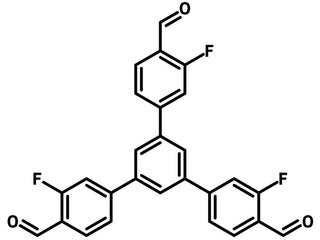1,3,5-Tris(3-fluoro-4-formylphenyl)benzene
CAS Number 2088007-04-7
Carbaldehyde Monomers, Chemistry Building Blocks, COF Ligands, Fluorinated Building Blocks,Covalent Organic Frameworks (COFs) Terphenyl Ligand
An aldehyde fluoro functionalized bridging ligand linker for COFs in application of fluorescence probe sensors, membrane, and detection of dopamine
Specifications | MSDS | Literature and Reviews
Trigonal 1,3,5-tris(3-fluoro-4-formylphenyl)benzene (TFFPB), CAS number 2088007-04-7, has a chemical structure of three 3-fluoro-4-formylphenyl groups sitting at the meta positions of a benzene ring. The aldehyde groups help to extend the structure to frameworks by forming covalent bonding and the fluoro-groups enhance the richness of the fluorine content of the targeted structures.
Constructed from 1,3,5-tris(4-aminophenyl) benzene (TPB) and 1,3,5-tri(3-fluoro-4-formylphenyl) benzene as the building elements at room temperature, porous covalent organic framework TPTF-COF is fluorine-rich, highly crystalline and thermally stable with rich functional group properties and large specific surface area of 1084.61 m2·g−1.
Containing 1,3,5-tris(3-fluoro-4-formylphenyl)benzene nodes and acrylonitrile linkages, smart COF showed rapid pH-responsive absorption and fluorescence, high fluorescence quantum yield, and good crystallinity. It exhibited a 20% enhancement in fluorescence quantum yield and more rapid sensitivity of absorption and fluorescence under acid–base induction compared to its nonfluorinated counterpart.
MOF and COF ligands
Fluoride and aldehyde ligand for cross-linked COF networks
Worldwide shipping
Quick and reliable shipping
High purity
>98% High purity
Duo functionality
Enabling post-functionalization
General Information
| CAS Number | 2088007-04-7 |
|---|---|
| Chemical Formula | C27H15F3O3 |
| Full Name | 1,3,5-Tris(3-fluoro-4-formylphenyl)benzene |
| Molecular Weight | 444.40 g/mol |
| Synonyms | TFFPB, 3,3''-Difluoro-5'-(3-fluoro-4-formylphenyl)-[1,1':3',1''-terphenyl]-4,4''-dicarbaldehyde |
| Classification / Family | Terphenyls, COF ligands, Fluorinated building blocks |
Chemical Structure

Product Details
| Purity | >98% |
|---|---|
| Melting Point | N/A |
| Appearance | White to yellow to orange powder/crystals |
MSDS Documentation
1,3,5-Tris(3-fluoro-4-formylphenyl)benzene MSDS Sheet
Literature and Reviews
-
Acrylonitrile-Linked Covalent Organic Frameworks Enable Fast Stimulus-Responsive Fluorescence with High Quantum Yield via Fluorine Chemistry, M. Yang et al., Adv. Photonic Res., 3 (8), 2200008 (2022); DOI: 10.1002/adpr.202200008.
-
Fluorine-Containing Covalent Organic Frameworks: Synthesis and Application, W. Li et al., Macromol. Rapid Commun., 44 (11), 2200778 (2023); DOI: 10.1002/marc.202200778.
-
Fabrication of high-crystallinity covalent organic framework and its nylon based membrane: Application in the enrichment and interception of dyes, J. Wong et al., J. Environ. Chem. Eng., 11, 110989 (2023); DOI: 10.1016/j.jece.2023.110989.
